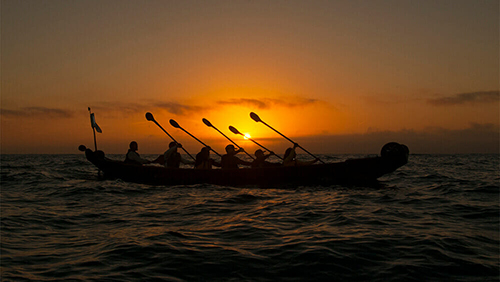The Chumash people have a maritime culture, as they were originally based on both the mainland and on the Santa Barbara Channel Islands. In addition to plant foods such as acorns, marine resources provided much of the subsistence base for Chumash food procurement. Two specific strategies were involved in obtaining marine food sources for Santa Barbara Chumash. The first involved taking advantage of low tides, when mussels, abalone, and other shellfish are often exposed and can be gathered. Seals and sea lions were also hunted on or near shore. The second strategy focused on intensive fishing activity using sophisticated capture technology such as hook and line, nets, and harpoons. This capture technology was also used in offshore fishing, utilizing seaworthy plank canoes or tomols.
Tomols were also used for trade between the mainland and the islands as well as for ceremonial voyages. Powered with double-ended paddles, tomols can transport five to eight people at a time or more than 2,000 pounds of fish or other cargo. Only one other civilization—located in Southern Chile—built plank canoes. Everyone else used dugouts or birch-bark canoes.
Estimated to be in use for more than 1,000 years, tomols were frameless canoes with no internal ribs, made mainly from redwood that washed up on the beaches of the mainland and Santa Barbara Channel Islands. Wima, the Chumash word for Santa Rosa Island, means “redwood driftwood.” The word tomol in the Chumash language meant both “canoe” and “pine” because the tomol was often made from pine planks. The best tomols, however, were made of redwood, which is softer and easier to craft than pine. It also swells and prevents leaks when wet. The Chumash split the wood logs into planks using wedges and deer antlers. The planks were carefully shaped, trimmed, leveled with scrapers, adzes (like an ax), and chert knives, and then finished with sharkskin sandpaper.

The tomol at the Santa Barbara Maritime Museum was constructed by (and is on loan from) the present-day Chumash Maritime Association.
The Chumash Use of Asphaltum
The Chumash were the first people to take advantage of Santa Barbara's local natural oil seeps and were known for their innovative use of asphaltum, using the substance to seal water-carrying baskets and waterproof ocean-going tomols.
Holes were bored into the planks of tomols using hand drills tipped with chert or bone. The planks were then fastened together with tok (dogbane or milkweed fiber). Once fitted and lashed, caulking tule (bulrush abundant in marshy areas) was forced into the cracks on the outside of the canoe hull. For waterproofing, yop, a mixture of pine pitch and hard asphaltum, was poured along the edge where the planks came together and into the holes where the cords were tied.
Asphaltum was also used to coat sewing strings and fishing spears, to seal tiny holes in abalone shells that became bowls, and in the construction and decoration of pipes and whistles. Similar to glue, asphaltum could be used to repair and seal fractures in broken bowls and vessels. Women even wadded up asphaltum to hold down the bottoms of their plant-fiber skirts. Yop was also used for lining the inside of baskets to be used as early water bottles.
Historic accounts and rare photographs of tomols make it possible to reconstruct these vessels, whose sturdy construction enabled the Chumash to navigate the Santa Barbara Channel. Today, the Chumash build tomols using modern tools and methods, as they recapture their nearly lost traditional tomol-building techniques. The efforts of the Chumash Maritime Association to recapture their maritime heritage are part of a thriving, extensive movement by West Coast tribal groups to reconstruct their seafaring traditions and pass them on to future generations.
